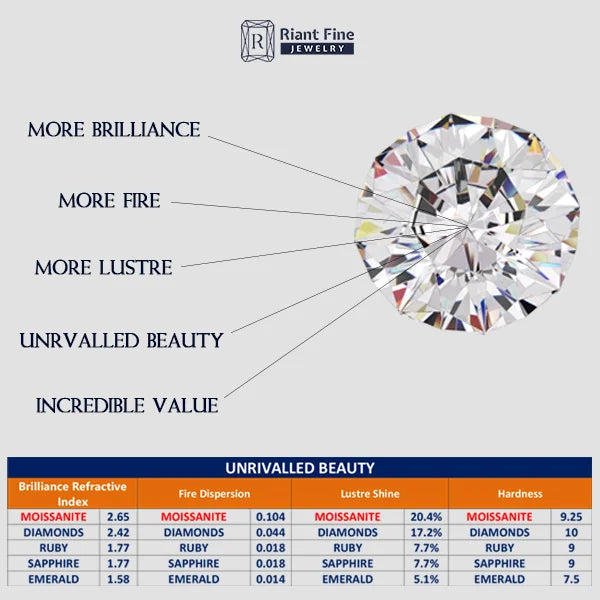The Eco-Conscious Choice
Opting for moissanite jewelry reflects an eco-conscious commitment. Lab-created moissanite avoids the environmental damage associated with mining and has a far smaller carbon footprint than diamonds or other gemstones. This makes it a sustainable and responsible alternative.

The History of Moissanite
The origins of moissanite can be traced back to a meteorite that struck the Arizona desert around 50,000 years ago.
In 1893, Dr. Henri Moissan, a Nobel Prize-winning French scientist, discovered samples from the meteor crater. The brilliant sparkle of these geological samples was astonishing. Dr. Moissan identified the material as a new mineral, Silicon Carbide, which was later named Moissanite in his honor.
Natural moissanite is extremely rare and too small for use in jewelry. However, a century later, advancements in science, technology, and gem cutting made moissanite available for exquisite jewelry pieces.
Over the past 20 years, moissanite has gained widespread popularity among jewelry enthusiasts around the world.

It’s All About Beauty
The Allure of Moissanite
Moissanite is one of the most stunning gemstones in the world.
It boasts unmatched brilliance, fire, and sparkle, enhancing any piece of jewelry.
The Refractive Index measures a gemstone's ability to capture and reflect light. The higher the refractive index, the brighter the jewel. With a refractive index of 2.65-2.69, moissanite surpasses diamonds.
Fire refers to the dispersion of white light into colorful flashes. The more dispersion, the more beautiful the jewel. Moissanite has 2.5 times the fire of diamonds, creating captivating color effects.
Luster, or scintillation, is the sparkle produced as a jewel moves in light. Moissanite has a luster rating of 20.4%, compared to a diamond's 17.2%.
With its stunning beauty and exceptional value, moissanite is perfect for any occasion.
Moissanite VS Lab Grown Diamond
Moissanite and lab-grown diamonds are both popular alternatives to natural diamonds, each with its own set of characteristics.
-
Moissanite
✧ Composed of silicon carbide (SiC) and is a distinct mineral with its own unique properties. It has a different crystal structure than diamonds.
-
Lab Grown Diamond
✧ Composed of carbon atoms arranged in a crystal lattice structure, identical to natural diamonds.
-
✧ Very hard, ranking 9.25 on the Mohs scale of hardness. It is durable and suitable for everyday wear.
-
✧ Shares the same hardness as natural diamonds, ranking 10 on the Mohs scale, making it the hardest known material.
-
✧ Exhibits a high degree of brilliance and fire, often displaying more colorful flashes of light than diamonds.
-
✧ Displays a similar level of brilliance and sparkle to natural diamonds, characterized by white light reflections.
-
✧ Generally exhibits more rainbow-like flashes of color, especially under certain lighting conditions.
-
✧ Can be produced with a range of colors, but high-quality diamonds are typically colorless or near-colorless.
-
✧ More affordable than both natural and lab-grown diamonds, making it a popular choice for budget-conscious buyers.
-
✧ Usually more affordable than natural diamonds but can still vary in price based on factors such as size, quality, and cut.
-
✧ Discovered in meteorites, but moissanite used in jewelry is typically created in a lab.
-
✧ Created in controlled laboratory conditions, replicating the natural diamond formation process.

Authenticity & Grading
Laser Engraving Identification
Each Eternal Brilliance stone is unique and features a laser-engraved code on the moissanite girdle. This code guarantees both authenticity and stone identification. The inscription is invisible to the naked eye and does not affect the stone's cut.
Certificate of Authenticity
Along with your finished ring, you will receive an official Eternal Brilliance Certificate of Authenticity. Our certificates are digital and encrypted, each one uniquely linked to its corresponding moissanite gemstone. This digital approach aligns with our ethical values and helps reduce our carbon footprint. However, we can provide a printed report upon request.

Choosing Your Gemstone
Moissanite or Cultured Diamond?
Moissanite stands out as a unique gemstone, much like sapphires and emeralds. It offers the same durability as diamonds and closely resembles their appearance, making it perfect for bridal jewelry.
Moissanite is a more affordable alternative to cultured diamonds, with prices ranging from $1,200 to $5,000. This allows you to achieve your dream ring design and carat size while staying within a reasonable budget.
For those seeking a high-quality diamond alternative that is both ethical and affordable, moissanite is the ideal choice.
Moissanite FAQ’s
Collapsible content
How is Moissanite made?
Moissanite is created through a thermal growing process using the natural mineral Silicon Carbide.
Moissanite is then hand cut to maximize its brilliance and fire.
Where does the name moissanite come from?
Moissanite was named in honour of its discoverer, french nobel prize-winner, dr. henri moissan.
Is moissanite graded like the four c's?
While it looks like diamond, moissanite is a different jewel than diamond with a different chemical composition.
as such, moissanite is not graded using the diamond grading system.
Why do you say moissanite has more brilliance?
The refractive index (ri) of a gemstone is the most important optical property affecting its potential brilliance (sparkle).
with an ri of 2.65-2.69, moissanite displays more brilliance than diamond (ri 2.42) or any other popular gemstone,
such as ruby (ri 1.77) and sapphire (ri 1.77).
What gives moissanite its superior fire?
Moissanite’s properties and master cutting creates high dispersion (“fire”).
moissanite’s dispersion is 0.104, which means it has more fire than diamond at 0.044.
fire is one of the three attributes that make up the beauty of a jewel, along with brilliance and lustre.
Will moissanite scratch or break easily?
While moissanite and diamond jewellery is extremely hard, durable and resistant to abrasion and chipping, like all other gemstones, they are not indestructible. care for your moissanite jewellery just as you would other fine jewellery, taking precautions not to wear rings and bracelets when doing rough work.
Do people buy moissanite rings for engagement and weddings?
Yes! due to moissanite’s beauty, durability, value and brilliance that lasts forever, it is very popular for engagement rings.








